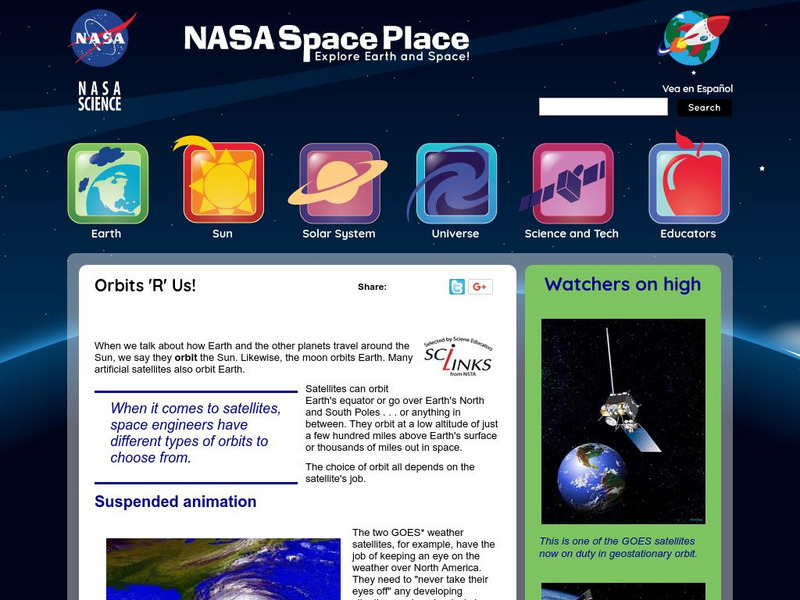Hi, what do you want to do?
Curated OER
Eight Planets
In this planets worksheet, 3rd graders use clues from a son "Eight Planets" write planet names under clues and visit a web link to complete a planet game. Link to song not given.
Curated OER
Reading Comprehension: Is Pluto a Planet?
In this reading comprehension worksheet, students read a passage about Pluto, then complete a set of 5 multiple choice questions. An answer key is included as well as a reference web site for additional activities.
Curated OER
Planetary Alignments
In this planetary alignments worksheet, students use 2 different methods to find out when planet alignments will occur. They use a three number series and they use least common multiples to find out when Mercury and Venus will align.
Curated OER
Equations of Lines Perpendicular and Parallel
In this algebra worksheet, students solve linear equations using one and two steps. They solve systems of equations using substitution and elimination with graphing. There are links for ready made tests and quizzes.
Curated OER
4th Grade Geography Multiple Choice
In this grade 4 geography activity, 4th graders complete a total of 25 multiple choice questions relating to 4th grade geography concepts. An answer key is provided.
Curated OER
Fall Lesson Plans
Fall lesson plans can combine science, history, and writing into an enticing combination.
Curated OER
Asteroids
In this worksheet on asteroids, students look at a picture asteroids and read accompanying facts, along with a brief paragraph.
Curated OER
Stargazing Astronomy: A Ceiling Full of Stars
Students make an observe a planetarium using a can with nail holes, black paper and a flashlight.
Curated OER
Explorit's Astronomy 2. Quiz
For this astronomy worksheet, students complete a five question multiple choice on-line interactive quiz about astronomy. Prior knowledge is assumed.
Curated OER
Estimation Quiz: Use a Table
For this estimation worksheet, students use information about planets, given in a table, to complete a 16 question quiz. Answers are included on page 2. A reference web site is given for additional activities.
Curated OER
Comparing Eclipses
In this eclipses worksheet, students will compare diagrams of a total solar eclipse with a total lunar eclipse. Students will complete 6 short answer questions based on these diagrams.
Curated OER
Electricity and Circuits
For this electricity and circuits worksheet, students read a 2 page article, answer 5 questions with multiple choice answers and read 10 statements and determine if they are true or false.
Curated OER
Make A Comet
Students make a comet out of corn syrup, ammonia, dirt, ice cream sticks, and more. In this comet lesson plan, students view how these ingredients turn from a solid to a gas.
Curated OER
Eclipse: An Introduction
Students write journal entries about eclipses with a focus on solar eclipses.
Curated OER
Ocean Currents Quiz
In this ocean instructional activity, students complete a 13 question multiple choice on-line interactive quiz about ocean currents. Prior knowledge is assumed.
NASA
Nasa: The Space Place: Orbits 'R' Us
Learn about how Earth orbits the sun and how satellites orbit the Earth. Discover the different types of satellites such as GOES and POES and what they are used to monitor.
Science Buddies
Science Buddies: Using the Soho to Determine the Rotation of the Sun
This project shows you how to use images from an orbiting observatory to measure how fast the Sun rotates.
PBS
Pbs News Hour Extra: Satellites Orbit the Sun to Better Predict Solar Storms
For the first time, NASA scientists have generated a full image of the sun, front and back, using twin orbiting satellites. The new view of Earth's star will allow for the study of solar weather events like coronal mass ejections that...
E-learning for Kids
E Learning for Kids: Egypt: How Do the Sun, Moon and Earth Revolve Around Each Other?
Omar helps his parents sell things at the market. Join him while he learns about the relationship of the Sun, Moon, and Earth.
PBS
Pbs Learning Media: The Sun and Planets
Observe the sun and the rotation of the planets in this moving image from NASA. Observe the axial tilts and directional rotation of planets and how they differ for each planet. Be sure to read the background information on how planets...
NASA
Nasa: The Solar and Heliospheric Observatory (Soho)
NASA provides a detailed overview of the Solar and Heliospheric Observatory (SOHO), currently orbiting the sun and gathering information on the sun's structure, composition and dynamics. Site includes images, movies, data, solar lessons,...
University of Colorado
University of Colorado: Ph Et Interactive Simulations: Gravity and Orbits
Move the sun, earth, moon, and space station to see how it affects their gravitational forces and orbital paths. Visualize the sizes and distances between different heavenly bodies, and turn off gravity to see what would happen without it.
University of Colorado
University of Colorado: Ph Et Interactive Simulations: Gravity and Orbits
An interactive simulation that teaches about gravitational force, circular motion, and astronomy by manipulating the sun, earth, moon, and a space station to observe the effects of gravity and orbital paths. This simulation can either be...
Science Buddies
Science Buddies: Tracking Geomagnetic Storms in the Ionosphere
The Sun is the ultimate source of the energy that powers weather systems on Earth. Geomagnetic storms are sun-powered storms in the upper atmosphere, arising from energized particles that are periodically ejected by the Sun. Among other...


























